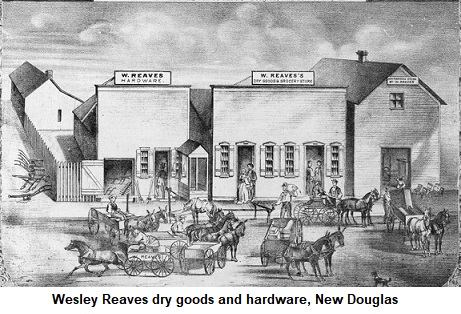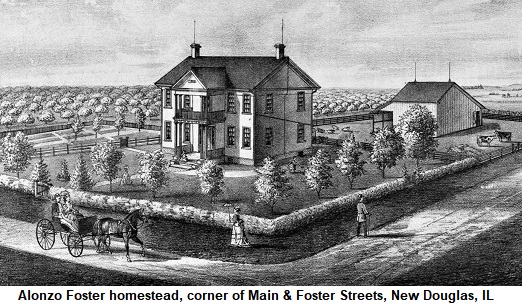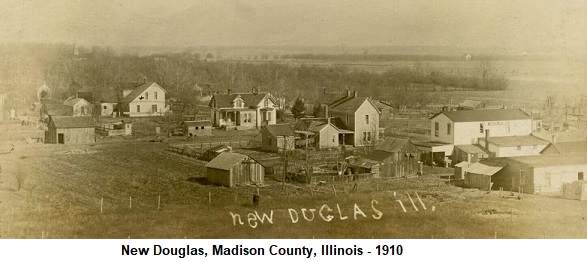Early History of New Douglas
New Douglas Newspaper Articles
Early Settlers
The first settler in New Douglas Township, located in the northeast
corner of Madison County, was Daniel Funderburk. He was a native of
South Carolina, born in 1786, and served through the War of 1812
under General Smith. Daniel and his wife, Mary, immigrated to New
Douglas Township in 1819, and for several years they were the only
residents of that area. In 1823, he taught the first school in a
small cabin built near his residence. Daniel’s wife, Mary, died
August 7, 1838. Hers was the first death of the township. Daniel
died on December 11, 1838, leaving behind a family of eleven
children, including his first-born son, John, who was the first born
in New Douglas Township. Sarah Funderburk, Daniel’s daughter, was
the first to marry in the township in 1834, to Aaron Voyles.
John L. Carlock arrived in the township about 1831. On December 14,
1833, he entered the first track of land in the northwest quarter of
the township, where he improved the forty-acre farm. He later moved
to Adams County. The Methodists held their early meetings at his
residence.
Cornelius Wood, a brother-in-law of Carlock, located on a place
southwest of Carlock’s about the same time. He improved a small farm
there and filled the office of Justice of the Peace. He later moved
to Bond County.
Robert Greening arrived in 1830, living to the south of Wood’s farm.
He was a strict member of the Baptist Church, and meetings were
conducted at his house regularly for many years. Jackson Allen, a
native of Virginia, came to Madison County in 1837, and settled in
New Douglas Township in the Spring of that year. He lived some
distance out in the prairie, where he improved a good farm until he
lost his wife in 1862. He then lived at his daughter’s home nearby
until his death in 1870. John P. Lindsey settled in the township in
1840. He was the second to settle out on the prairie.
The Founding of New Douglas
In 1857, Alonzo Foster (his father, Oliver Foster, was a pioneer
settler of Fosterburg in Madison County) moved to New Douglas
Township, then an open prairie, and laid out the town of New
Douglas. The town was platted September 5, 1860, and contained 20
acres east of the present Main Street. Later, Foster and Mr. Owens
laid out an addition on the west side of the street. Alonzo Foster
donated land for the city cemetery in the north part of town. It has
been enlarged several times.
The post office in New Douglas was established in 1863, and mail was
received twice a week from Staunton. J. W. Lord was the first
postmaster. In later years, postmasters include Frank Alsop, W. W
Livingston, Dora Blair, Eugenia Prange, John Johnson, E. W. Bunn,
and L. R. Wall.
Early Businesses in New Douglas
In 1860, Costen Sawyer erected the first business house, in which he
opened a small stock of goods. The same year, he built a blacksmith
shop and employed John Trype. Trype afterward conducted a shop of
his own.
The second store was started by Dr. William F. Rubottom in 1863.
Rubottom was the first physician in New Douglas. He practiced
medicine for about five years, and then went West.
The first hotel in New Douglas was constructed in 1876 by Rodo
Latowsky.
Alonzo Foster built a home on the corner of Main Street and Sorento
Road. He lived there for many years with his family. Later the home
was sold to Otto and Cora Latowsky. Across the street from the
Foster home was the John Vollentine and Joe Crowder homes.
Vollentine was one of the original members of the Old Settler’s
Association. He donated the park where the Old Settler’s picnics
were held (on Main Street).
The Murdock and Fletcher Flour Mill was established in 1879. They
later sold to Amos and Anna Easton.
I. A. “Red” Olive operated a hardware story for many years. Marney
and Foster maintained a grocery store in the building that later
became the village hall. The building was also used by the New
Douglas Fire Department.
Robert Alsop owned and operated a grocery store, and also ran an
undertaking establishment. Later, Hugo Latowsky established an
undertaking business and furniture store, in an addition built onto
the Latowsky store building. This was used until a modern
undertaking parlor was constructed on Sixth Street.
Paul Douglas was a harness maker and shoe cobbler. Mrs. Tillie
McMullen was the village dressmaker. William Kline and “Dart” Foulke
operated barber shops, and J. F. Smith owned a wagon shop and
blacksmith shop.
The New Douglas livery occupied a prominent place in the history of
the village. At one time, a horse and buggy met all the incoming
trains and hauled travelers and their baggage from the station to
uptown. Many “drummers,” or salesmen, would be among the travelers,
and after completing their work in New Douglas, they would hire a
rig to take them to neighboring towns of Sorento, Staunton, or
Alhambra.
Brothers August and William Prange constructed the brick flour mill
in the south part of town, near the railroad station. It was later
operated as a feed mill by Edward Rosenthal and son. In addition to
operating the flour mill, they branched out into the merchandising
business, operating a general store. They also established the
Prange Bank.
On February 27, 1875, a violent cyclone passed through the west part
of town, traveling northeast. It demolished 11 buildings, including
2 churches, the schoolhouse, and the Masonic Hall. Reverend Henry C.
Young, the Methodist minister, was killed while conducted an
afternoon meeting.
By 1962, out of all the old business houses of the 1900s, only the
Van Delph Building, later known as Bunns Drugstore, and the Masonic
Hall were still standing. The drugstore owned by Robert Livsey was
destroyed by fire on July 4, 1895. The Robert Alshop building was
used as a telephone office, and operated by Mrs. Mae Bunn
Schoenmetzler for 35 years. It has since been torn down. The Nickle
Plate Railroad Depot has been moved to the Catholic church yard, and
converted into a parish hall.
Early New Douglas Schools
The first schoolhouse in New Douglas was erected by Daniel
Funderburk in 1823. He was the first settler in the New Douglas
Township, and built a log schoolhouse near his home. Funderburk died
in 1838. The second schoolhouse, a log building, was erected in
1839. Nelson Sparks was its first teacher. Other early school
teachers include Joe Crowder, L. T. Kennedy, A. N. Lewis, W. E.
Lewis, E. W. Bunn, E. M. Sievers, and Elizabeth Fletcher.
A two-story frame schoolhouse was constructed in 1879. This was used
until about 1901, when half of the building was moved to Main Street
by Robert McFarland, who operated a popular ice cream parlor and
confectionery. The other half was used as a residence by George
Eardley. In 1904 a new brick schoolhouse was constructed in the
northwest part of town. This was used until 1953. The building was
later owned by the American Legion. Later, a modern, four-room grade
school was constructed, with gymnasium and cafeteria. New Douglas
became part of the Highland Community School District, and the high
school students attended there.
Early New Douglas Churches
The New Douglas Southern Methodist Church was constructed in 1867.
The Baptist church was build in 1869, and the Catholic church was
constructed in 1870. The Lutheran church was constructed in 1874,
and the Northern Methodist church was built in 1877. The Christian
church was built in 1878. Of these, only the Baptist, Catholic,
Lutheran, and Christian were still standing in 1962.

